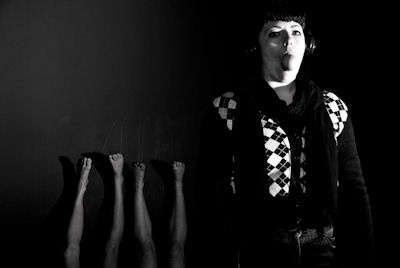Hybrid art involving sound and the body provides a rich melange in HEAR ME, the second event of this year’s LIVE SERIES by the Producing Project, this time presented in the cosy Old Folks Hall on Gundry Street. These new works by independent dance and performance artists are more -or-less experimental and largely still in progress. Taken collectively, they offer a relatively representative sampling of contemporary performance genres in Auckland.
The sound sources range widely, including 2000 year old Chinese zither (gu zheng), a rap song composed this week, a poetic soliloquy from 1922, field recordings made earlier this year in European towns, the sound of breaking eggs, amplifier static and slamming doors, recorded journal fragments intercut with atmospheric electronica, and improvisation over beats. Despite the theme of experimentation, there’s a more or less traditional relationship of sound to movement in this evening of curated works — the sound acts as accompaniment, narrative thread, cue and trigger, motivation or inspiration for choreographed performances.
Becca Wood’s in-the-round Instructions for re-membering (forwards): a slide show is arguably the most experimental work of the evening, dealing as it does with the absence of the expected, the way sound conjures presence for us, and the way our memories of places are embodied in the movements we share with others. It is also the least traditional in its relationship of sound and body, demonstrating their disjunction.
Standing in the middle of the audience, Wood tells us that she has been travelling recently in Europe and that she wants to share some experiences with us. She unpacks a slide projector from her roll-along suitcase, and plugs it in. The lights come on, and a series of field recordings rolls — a train station, church bells, street sounds, a salsa band, drums, yodelling – with her litany of places visited running beneath. Four people move about the space apparently following instructions via ipod and headphones, as if in a museum. These atomised individuals perform everyday movements which nevertheless suggest the experience of travellers- taking photos, pointing into the distance, lying on the ground, walking briskly or very slowly around and about, or sustaining poses for long periods, shading their eyes, cupping their ears, looking up into the sky, gesturing with their hands, resting by sitting on the ground.
By the end you feel as if you have been on a long journey, seen many sights, experiences many interactions — and you realise that there were no slides, such traditional media of the traveller having been discontinued in 2009.
A different kind of absence is conjured by Yi Minority Dance, a traditional Chinese dance score played on the guzheng by Andrea Sun. Sun vigorously plucks and presses, strums, flicks and picks the 20 or so strings of the zither, her right hand acting as the rhythm section and tremolo while her left hand provides both bold and subtle ornamentation ranging from cascading waterfall sequences, runs and rills, to repeated single notes. The musician’s feet are firmly planted on the floor and her legs rarely move, but the upper body is highly articulate, the arms and hands limber and quick, precise, the upper body curving forward or stretching laterally to encompass her reach down the length of the zither. Although we see no dancer, the musician clearly does, and the invisible spectre seems to be left behind in the room with us.
By contrast, Molly Bloom from James Joyce’s Ulysees (1922) is distinctly here in the room with us for the duration of the beautifully nuanced Bloom (1989) choreographed by Canadian Margie Gillis and impressively danced by Lydia Bittner Baird. This is no work in progress, it is whole cloth — a very tricky interpretive dance set to the eight extraordinarily long sentences of Molly Bloom’s soliloquy, echoing the flickering cadences of the stream of consciousness text and its fleeting references to the thoughts passing through Molly’s mind as she lies in bed beside her husband. The choreography masterfully interweaves naturalistic, figurative, symbolic and abstract movements to reflect a selection of the umpteen events recounted in the text, and the dancer magically flickers in and out of the multiple personas introduced in the recounting of events, revealing the real amidst the poetic, and ending on an exultant Yes!. which is corporeally shouted.
The other works touch on disparate themes – the smashing of eggs symbolically representing experiences of miscarriage in Misa Tupou’s Eggs performed by Hear Me artists; a disturbed, fragmented persona represented by backwardly worn clothing and reversed movement sequences in Christina Houghton’s solo I am Still Here; and the patterning and disruption of digital communication is referenced in improvisational breakdance with labels by Rapz Maihi with music by Josh Tilsley in 07734.
The ebb and flow of relationships amongst three very close friends is presented by SMS Collective with live rap from Taaz MC in "And it was like…", in a conventional kind of contemporary dance choreography in which two dancers are always watched by the third who is for the moment the one pushed out of close connectivity. Similarly, but with a good deal more experimentation in the physicality of the body, Chris Tempest and Kate Bartlett in Preceding the Thread depict an uncosy domestic partnership between two people who are almost always together. Some wonderful moments here with a good deal of wry humour and byplay around an amplifier, its cable, and a missing electric guitar.
Taken collectively, the evening’s works also justify the curatorial provocation — and open up further possibilities for exploration.
__________________________________________________________________________________
For more production details, click on the title above. Go to Home page to see other Reviews, recent Comments and Forum postings (under Chat Back), and News.
Copyright © in the review belongs to the reviewer





Comments